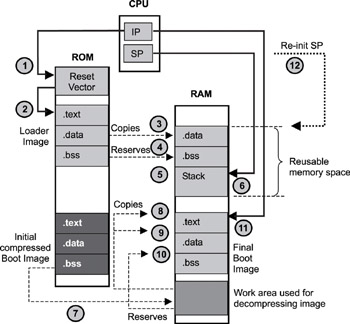Книга: Real-Time Concepts for Embedded Systems
3.3.2 Executing from RAM after Image Transfer from ROM
3.3.2 Executing from RAM after Image Transfer from ROM
In the second boot scenario, the boot loader transfers an application image from ROM to RAM for execution. The large application image is stored in ROM in a compressed form to reduce the storage space required. The loader must decompress this image before it can initialize the sections of that image. Depending on the compression algorithm used and whether enough space is left in the ROM, some state information produced from the compression work can be stored to simplify image decompression. The loader needs a work area in RAM for the decompression process. It is common and good practice to perform checksum calculations over the boot image to ensure the image integrity before loading and execution.
The first six steps are identical to the previous boot scenario. After completing those steps, the process continues as follows:
7. The compressed application image is copied from ROM to RAM.
8-10. Initialization steps that are part of the decompression procedure are completed.
11. The loader transfers control to the image. This is done by “jumping” to the beginning address of the initialized image using a processor-specific “jump” instruction. This “jump” instruction effectively sets a new value into the instruction pointer.
12. As shown in Figure 3.4, the memory area that the loader program occupies is recycled. Specifically, the stack pointer is reinitialized (see the dotted line) to point to this area, so it can be used as the stack for the new program. The decompression work area is also recycled into the available memory space implicitly.

Figure 3.4: Boot sequence for an image executing from RAM after transfer from ROM.
Note that the loader program is still available for use because it is stored in ROM. Making the loader available for later use is often intentional on the designer’s part. Imagine a situation in which the loader program has a built-in monitor. As mentioned earlier, part of the monitor startup sequence is to install default interrupt handlers. This issue is extremely important because during the development phase the program under construction is incomplete and is being constantly updated. As such, this program might not be able to handle certain system interrupts and exceptions. It is beneficial to have the monitor conduct default processing in such cases. For example, a program avoids processing memory access exceptions by not installing an exception handler for it. In this case, the monitor takes control of the system when the program execution triggers such an exception, for example, when the program crashes. The developer then gets the opportunity to debug and back-trace the execution sequence through the monitor inter- face. As indicated earlier, a monitor allows the developer to modify the processor registers. Therefore, as soon as the bug is uncovered and a new program image is built, the developer can set the instruction pointer register to the starting address of the loader program in ROM, effectively transferring control to the loader. The result is that the loader begins to download the new image and reinitializes the entire system without having to power cycle on the system.
Similarly, another benefit of running the loader out of the ROM is to prevent a program that is behaving badly from corrupting its code in systems without protection from the MMU.
In this example, the loader image is in an executable machine code format. The application image is in the ELF format but has been compressed through an algorithm that works independently of the object file format. The application image is in the ELF format so that the loader can be written as a generic utility, able to load many application program images. If the application image is in the ELF format, the loader program can extract the necessary information from the image for initialization.
- 3.3.3 Executing from RAM after Image Transfer from Host
- Инструкция INSERT INTO ... FROM ... UNION ...
- Parameter problem
- 1.2.2 ROM
- 2. How to Apply These Terms to Your New Programs
- Creating CDs from the Command Line
- The Programmers
- Chapter 2 Building and Deploying a Run-Time Image
- 7.3.2. EEPROM и флэш-память
- Глава 4. Этаж Promotion
- Instagram как платформа для реализации.
- Специфика .NET Compact Framework: ADO.NET




